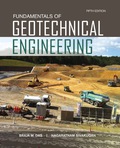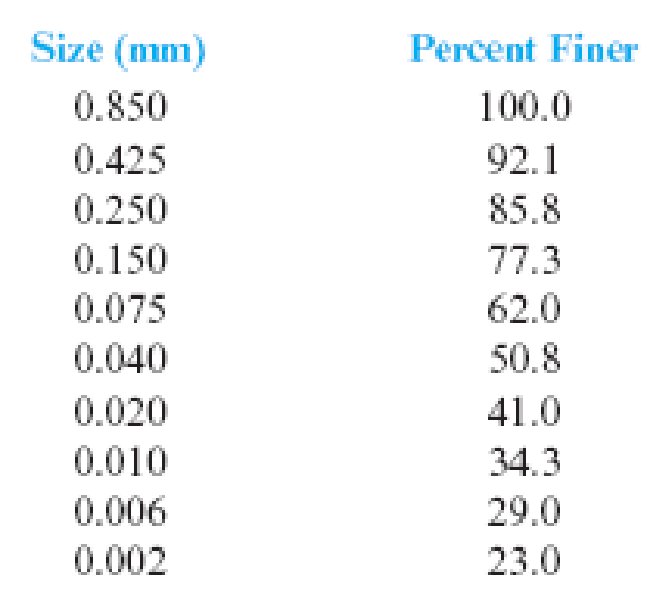
EBK FUNDAMENTALS OF GEOTECHNICAL ENGINE
5th Edition
ISBN: 8220101425829
Author: SIVAKUGAN
Publisher: CENGAGE L
expand_more
expand_more
format_list_bulleted
Concept explainers
Textbook Question
Chapter 2, Problem 2.8P
Redo Problem 2.7 according to the USDA system (Table 2.3).
2.7 The particle characteristics of a soil are given below. Draw the particle-size distribution curve and find the percentages of gravel, sand, silt, and clay according to the MIT system (Table 2.3).

Expert Solution & Answer
Trending nowThis is a popular solution!

Students have asked these similar questions
Problem 4 (Apx Method)
Determine (approximately) the force in each member of the truss. Assume the diagonals can support
both tensile and compressive forces.
3 m
50 kN
F
000
40 kN
000
000
000
000
000
000
E
000
000
000
000
000
B
3 m
20 kN
D
000
000
000
000
C
3 m
Problem 5 (Apx Method)
Determine (approximately) the force in each member of the truss in problem 4. Assume the diagonals
cannot support compressive forces.
The single degree of freedom (SDOF) system the acceleration at the base (excitation) and the acceleration at the roof (response) of the SDOF system was recorded with sampling rate 50 Hz (50 samples per second, or dt= 0.02 seconds). The file ElCentro.txt includes the two columns of acceleration data. The first column lists the acceleration at the base of the SDOF system. The second column lists the acceleration at the roof of the SDOF system. (a) Plot the time histories of the recorded accelerations at the base and at the roof of the SDOF system. (b) Compute the acceleration, velocity and displacement time histories of the roof of the SDOF system subjected to the recorded base acceleration using the Central Difference method. Plot the accel- eration, velocity and displacement time histories. Plot the restoring force, the damping force, and the inertia force time histories. Compare the recorded acceleration time history at the roof of the SDOF with the acceleration that you computed…
Problem 2 (Using force method)
Determine the force in each member of the truss. E = 29000 ksi
3 k
1.5 in²
4 ft
1.5 in²
1.5 in²
2 in²
6 k
D
1.5 in²
3 ft
2 in²
B
Chapter 2 Solutions
EBK FUNDAMENTALS OF GEOTECHNICAL ENGINE
Ch. 2 - Prob. 2.1PCh. 2 - Following are the results of a sieve analysis: a....Ch. 2 - For a soil, given: D10 = 0.08 mm D30 = 0.22 mm D60...Ch. 2 - For a soil, given: D10 = 0.08 mm D30 = 0.22 mm D60...Ch. 2 - Repeat Problem 2.2 with the following results of a...Ch. 2 - Repeat Problem 2.2 with the following results of a...Ch. 2 - The particle characteristics of a soil are given...Ch. 2 - Redo Problem 2.7 according to the USDA system...Ch. 2 - Redo Problem 2.7 according to the AASHTO system...Ch. 2 - In a hydrometer test, the results are as follows:...
Knowledge Booster
Learn more about
Need a deep-dive on the concept behind this application? Look no further. Learn more about this topic, civil-engineering and related others by exploring similar questions and additional content below.Similar questions
- The single degree of freedom (SDOF) system that you studied under free vibration in Assignment #3 - Laboratory Component has been subjected to a strong ground motion. The acceleration at the base (excitation) and the acceleration at the roof (response) of the SDOF system was recorded with sampling rate 50 Hz (50 samples per second, or dt= 0.02 seconds). The file ElCentro.txt includes the two columns of acceleration data. The first column lists the acceleration at the base of the SDOF system. The second column lists the acceleration at the roof of the SDOF system. (a) Plot the time histories of the recorded accelerations at the base and at the roof of the SDOF system. (b) Compute the acceleration, velocity and displacement time histories of the roof of the SDOF system subjected to the recorded base acceleration using the Central Difference method. Plot the accel- eration, velocity and displacement time histories. Plot the restoring force, the damping force, and the inertia force time…arrow_forwardPlease explain step by step and show formulaarrow_forwardPlease explain step by step and show formulaarrow_forward
- For an reinforced concrete two-way slab shown in figure under the load (P). (the slab continuous over all edges - all sides are fixed), Determine (By using yield line theory): A- Draw the Yield line Pattern B- Determine the moment m 3BAT C- Find The required flexural steel to resist the loads causing the slab to collapse if P = 200 KN, fc = 28 MPa, fy = 420 MPa d = 120 mm. Use 10 mm bars. (Pmin = 0.002) 6m 8m >2m->) 3marrow_forward3BAT For an reinforced concrete two-way slab shown in figure under the load (P). (the slab continuous over all edges - all sides are fixed), Determine (By using yield line theory): A- Draw the Yield line Pattern B- Determine the moment m KN, fc Please don't solve in Al anco if P = 200 6m 8m 2m-)) 3marrow_forwardPlease explain step by step and show formulaarrow_forward
- Please explain step by step and show formulaarrow_forward4-You are making a bookshelf (shown below) to carry books that range from 8½" to 11" in height and would take up 29" of space along the length. The material is wood having a Young's Modulus of 3.66 ksi, thickness of 3/8", and width of 12". You want to find the maximum vertical deflection of the bookshelf. The vertical deflection of the shelf is given by: -0.67665 x10 8x4 -0.26689x105 x3 +0.12748x10³ x² -0.018057=0 x Bookshelf Booksarrow_forwardThe difference in water surface levels in two tanks, which are connected by three pipes in series of lengths 300 m, 170 m, and 210 m, having diameters 300 mm, 200 mm, and 400 mm, respectively, is 12 m. Determine the rate of flow of water if coefficients of friction are 0.005, 0.0052, and 0.0048, respectively. Determine the discharge and velocity in each pipe, considering the minor losses and neglecting minor losses.arrow_forward
- 3 BAT For an reinforced concrete two-way slab shown in figure under the load (P). (the slab continuous over all edges - all sides are fixed), Determine (By using yield line theory): A- Draw the Yield line Pattern B- Determine the moment m C- Find The required flexural steel to resist the loads causing the slab to collapse if P = 200 KN, f=28 MPa, fy = 420 MPa d = 120 mm. Use 10 mm bars. (Pmin = 0.002) 6m 8m >2m-)) 3marrow_forwardREINFORCED CONCRETE DESIGNANALYSIS OF SINGLY REINFORCED BEAMS (STRENGTH DESIGN METHOD)Direction:Solution must be completeUse ballpen/inkpenAnswer in two decimal placesBox your final answerarrow_forwardE. Estimate the required air flow rate for the new activated sludge plant at Camp Verde Problems 23-3 — 23-823-11, and 23-14 B). Use the following assumptions in preparing the estimate: Clean water correction, a 0.70 . Salinity correction, ẞ= 0.95 . Fouling factor = 0.8 Summer wastewater temperature 22°C • Atmospheric pressure 101.325 kPa .Elevation 2,135 m Depth of aerator = 4.5 m Operating DO = 2.0 mg/L Percent oxygen leaving aeration tank - 19% Manufacturer's SOTR = 650 kg/d • Manufacturer's air flow rate at standard conditions 20 m3/d aerator 23-3. The town of Camp Verde has been directed to upgrade its primary WWTP to a secondary plant that can meet an effluent standard of 25.0 mg/L BOD5 and 30 mg/L suspended solids. They have se- lected a completely mixed activated sludge system for the upgrade. The existing primary treatment plant has a flow rate of 2,506 m³/d. The effluent from the primary tank has a BOD5 of 240 mg/L. Using the following assumptions, estimate the required…arrow_forward
arrow_back_ios
SEE MORE QUESTIONS
arrow_forward_ios
Recommended textbooks for you
 Principles of Geotechnical Engineering (MindTap C...Civil EngineeringISBN:9781305970939Author:Braja M. Das, Khaled SobhanPublisher:Cengage Learning
Principles of Geotechnical Engineering (MindTap C...Civil EngineeringISBN:9781305970939Author:Braja M. Das, Khaled SobhanPublisher:Cengage Learning Fundamentals of Geotechnical Engineering (MindTap...Civil EngineeringISBN:9781305635180Author:Braja M. Das, Nagaratnam SivakuganPublisher:Cengage Learning
Fundamentals of Geotechnical Engineering (MindTap...Civil EngineeringISBN:9781305635180Author:Braja M. Das, Nagaratnam SivakuganPublisher:Cengage Learning Principles of Foundation Engineering (MindTap Cou...Civil EngineeringISBN:9781337705028Author:Braja M. Das, Nagaratnam SivakuganPublisher:Cengage Learning
Principles of Foundation Engineering (MindTap Cou...Civil EngineeringISBN:9781337705028Author:Braja M. Das, Nagaratnam SivakuganPublisher:Cengage Learning Construction Materials, Methods and Techniques (M...Civil EngineeringISBN:9781305086272Author:William P. Spence, Eva KultermannPublisher:Cengage Learning
Construction Materials, Methods and Techniques (M...Civil EngineeringISBN:9781305086272Author:William P. Spence, Eva KultermannPublisher:Cengage Learning Traffic and Highway EngineeringCivil EngineeringISBN:9781305156241Author:Garber, Nicholas J.Publisher:Cengage Learning
Traffic and Highway EngineeringCivil EngineeringISBN:9781305156241Author:Garber, Nicholas J.Publisher:Cengage Learning Principles of Foundation Engineering (MindTap Cou...Civil EngineeringISBN:9781305081550Author:Braja M. DasPublisher:Cengage Learning
Principles of Foundation Engineering (MindTap Cou...Civil EngineeringISBN:9781305081550Author:Braja M. DasPublisher:Cengage Learning

Principles of Geotechnical Engineering (MindTap C...
Civil Engineering
ISBN:9781305970939
Author:Braja M. Das, Khaled Sobhan
Publisher:Cengage Learning

Fundamentals of Geotechnical Engineering (MindTap...
Civil Engineering
ISBN:9781305635180
Author:Braja M. Das, Nagaratnam Sivakugan
Publisher:Cengage Learning

Principles of Foundation Engineering (MindTap Cou...
Civil Engineering
ISBN:9781337705028
Author:Braja M. Das, Nagaratnam Sivakugan
Publisher:Cengage Learning

Construction Materials, Methods and Techniques (M...
Civil Engineering
ISBN:9781305086272
Author:William P. Spence, Eva Kultermann
Publisher:Cengage Learning

Traffic and Highway Engineering
Civil Engineering
ISBN:9781305156241
Author:Garber, Nicholas J.
Publisher:Cengage Learning

Principles of Foundation Engineering (MindTap Cou...
Civil Engineering
ISBN:9781305081550
Author:Braja M. Das
Publisher:Cengage Learning
How Are Highways Designed?; Author: Practical Engineering;https://www.youtube.com/watch?v=9XIjqdk69O4;License: Standard Youtube License